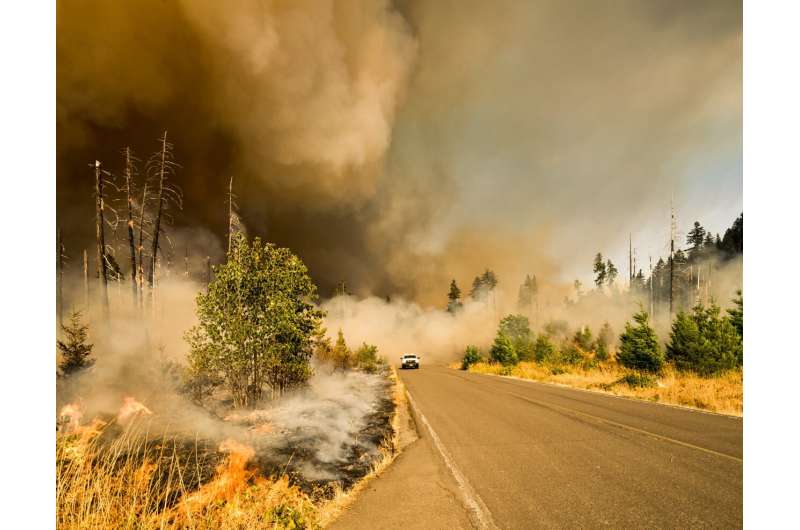This article has been reviewed according to Science X's editorial process and policies. Editors have highlighted the following attributes while ensuring the content's credibility:
fact-checked
reputable news agency
proofread
How wildfire smoke, retardant slurry impact human health, environment

While flames may be the most visual wildfire danger, experts say smoke and fire retardant slurry can have long-lasting effects on human health and the environment.
New research has linked wildfire smoke exposure to higher rates of dementia, reproductive health issues and lung and heart disease, and forest service employees say the iconic, red fire retardant slurry dropped out of planes has been linked to thousands of fish kills.
"There are hundreds of gases that are emitted from wildfire smoke, some of them in very, very small quantities," National Center for Atmospheric Research scientist Rebecca Hornbrook said. "Some—like carbon monoxide, carbon dioxide and nitrogen oxides—are emitted in higher quantities, but some of those smaller quantity gases are actually even more toxic."
Short-term effects of wildfire smoke
"Everyone can be impacted by wildfire smoke," said Colleen Reid, an associate professor at the University of Colorado Boulder who studies the health impacts of wildfire smoke. "…We see increases in health impacts within one day of high smoke exposure."
Normal symptoms when smoke is heavy in the air include coughing, shortness of breath, headaches, tiredness, chest pain and itchy and watery eyes, Reid said. Emergency room visits and hospitalizations for respiratory problems also go up when smoke is active.
Mild symptoms often go away within a day or two of smoke clearing from the area, according to Reid.
In addition to smoke, wildfires also leave behind ash that can irritate the lungs, eyes, nose and skin, according to the Centers for Disease Control and Prevention.
As residents clean up areas impacted by a wildfire, they should wear protective clothing and goggles and wash off any ash that gets on their skin, eyes or mouth as soon as possible, according to the CDC.
Researchers exploring long-term health impacts of smoke
"We know a lot about the short-term health impacts of wildfire smoke exposure, we know less about long-term effects," Reid said.
According to Reid and David González—an assistant professor of environment health sciences at the University of California Berkeley who works with Colorado researchers to determine the long-term impacts of wildfire smoke exposure—recent studies have linked wildfire smoke exposure to increased cases of the flu, decreases in lung function, and higher rates of depression, anxiety and dementia.
The increase in influenza cases was first noticed after a bad wildfire season several years ago, and researchers believe that exposure to wildfire smoke may have made people's lungs more susceptible to infection when exposed to the virus, Reid said.
According to González, wildfires also impact cardiovascular health—smoke can trigger heart attacks and strokes, worsen heart failure, cause abnormal heart rhythms or exacerbate pre-existing heart disease—and reproductive health—smoke increases the risk of birth defects, miscarriage and infertility in both men and women.
Reid said people can start seeing health impacts—both short-term and long-term—after just one day of high smoke exposure.
Sometimes, smoke from fires farther away can cause more significant health impacts on communities than fires nearby, according to a recent study from Colorado State University.
Researchers believe that's more likely due to changes in behavior than the distance of the smoke itself, Reid said. People who see the fire or smell the smoke may be more likely to take proactive and protective measures than people farther away from the burn site.
While how far the smoke travels depends on the wind, weather and how high the smoke is in the atmosphere, researchers are seeing an increase in air pollution across the world, even in places where wildfires are uncommon or non-existent, González said. Smoke can be traveled to states or even countries away.
"If there is smoke, try to stay indoors with windows and doors closed," Reid said. "Wear an N95 or KN95 mask when outdoors and try to time your outdoor activities to when the air is cleanest."
Reid said people should use air cleaners in indoor places and frequently replace filters on air cleaners and air conditioning units—the smoke can clog up the filters and prevent them from helping.
"There's so much more work to be done here," González said. "This isn't the end of the story."
Health, environmental impacts of fire retardant
Wildfire retardants contain about 85% water, 10% ammonium phosphate fertilizer and 5% minor ingredients—including a colorant to help pilots see where the slurry has already been dropped—according to former U.S. Forest Service employee Andy Stahl.
"It's bad for the environment when it's dumped into water because the ammonium phosphate turns into ammonia and ammonia is highly toxic to fish," Stahl said. The former U.S. Forest Service employee currently serves as the executive director of Forest Service Employees for Environmental Ethics. A single drop of fire retardant in a stream can be lethal to fish and other aquatic organisms.
Under "very specific conditions," the fertilizer may poison animals that have eaten contaminated crops or drank water with retardant in it, according to the U.S. Forest Service.
However, as long as people aren't standing under the retardant as it's dropped, the mixture hasn't shown any signs of long-term health impacts on humans, Stahl said.
The ammonia-based fire retardant will sting if it gets into cuts or scratches, or if it comes into contact with chapped or burned skin, according to the U.S. Forest Service. People should wash any skin that comes into contact with the slurry with water and soft soap, before using a hand cream to avoid dryness and cracking.
If retardant gets dropped on homes, residents should clean off the building as soon as possible, Boulder fire officials said. However, the retardant-covered homes should be safe to stay in until they can be cleaned.
2024 MediaNews Group, Inc. Distributed by Tribune Content Agency, LLC.


















